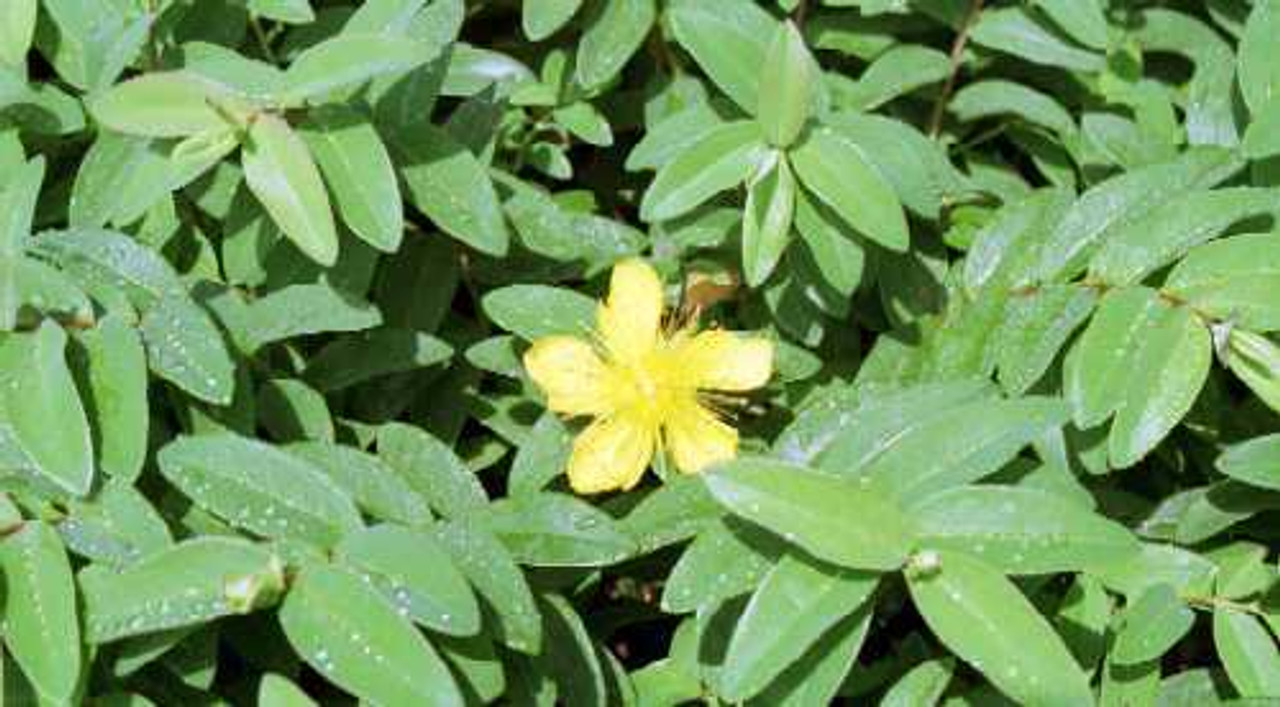Product Description
Hypericum calycinum 'St. Johns Wort'
a/k/a Aaron's beard, creeping St. John's wort
Zones: 5/6 to 9/10; Full sun to part shade.
Mature size can reach 12 to 24 inches height.
semi-evergreen subshrub or shrublet.
Hypericum calycinum, commonly known as St. John's Wort or Aaron's Beard, is a charming and versatile groundcover prized for its bright yellow flowers and lush green foliage. It is a popular choice for adding a splash of color and texture to gardens, especially in challenging areas like slopes or under trees.
- Vibrant yellow flowers: The star-shaped, golden yellow flowers bloom profusely from mid-summer to fall, creating a cheerful display that brightens up any landscape. Each flower features five petals surrounding a prominent tuft of bushy stamens, adding a touch of elegance to the blooms.
- Lush evergreen foliage: The oval-shaped, dark green leaves provide a beautiful backdrop for the flowers and remain attractive year-round, adding texture and interest to the garden even when not in bloom.
- Spreading habit: Hypericum calycinum spreads rapidly by underground stems, forming a dense mat that effectively suppresses weeds and stabilizes slopes. This makes it an excellent choice for ground cover or erosion control.
- Low maintenance: Once established, it is a relatively easy-care plant that requires minimal attention. It is drought-tolerant and deer-resistant, making it a great option for busy gardeners or those with challenging growing conditions.
- Versatile use: Hypericum calycinum can be used in various garden settings, including borders, rock gardens, woodland gardens, and even as a ground cover under trees. It is a great way to add a touch of color and texture to any landscape.
Growing Tips:
- Planting: Plant Hypericum calycinum in spring or fall in well-drained soil and full sun to partial shade. Space plants about 18 inches apart to allow for spreading.
- Watering: Water regularly during the first year to help the roots establish. Once established, it is drought-tolerant but appreciates occasional watering during prolonged dry spells.
- Fertilizing: Apply a balanced fertilizer in early spring before new growth begins.
- Pruning: Trim lightly in late winter or early spring to maintain a compact shape and encourage further blooms.
- Pest and disease resistance: Hypericum calycinum is generally pest and disease-resistant, but watch for rust or wilt, especially in humid climates.
Overall, Hypericum calycinum is a delightful and easy-to-grow plant that adds a touch of sunshine to any garden. Its vibrant yellow flowers, lush evergreen foliage, and low-maintenance nature make it a great choice for gardeners of all levels.
Leaves emerges chartreuse-bronzed but quickly turns to medium green then dark green in sunny area; and lighter, yellowish green in shade. Fall color is more of a deep blue-green. Large (2 to 3 inch), rose-like bright canary yellow flowers appear singly or in groups of 2 to 3 and cover the plant in June and July and sporadically through September.
Prefers moist, well-drained, average fertile soil in partial shade; St. Johns Wort is tolerant of a wide range of well-drained soils. Evergreen in warm winter climates, may suffer some tip dieback in cold winter climates, but blooms on new growth each spring. Shear or mow plants in late winter or early spring every 2 to 3 years to induce new growth. Spreads rapidly by underground stems and can be invasive in ideal growing conditions.
Use as ground cover, rock gardens, border fronts, naturalized plantings, and excellent for embankments or hillsides. Versatile plant can be used as a flowering shrub or ground cover. Good for planting under trees where it competes well with shallow tree roots.
Not that we are making any recommendations, but historically St. Johns Wort has been used as an antiseptic and anti-depressant.
Eighteen (18) plants in 3.5-inch containers per flat (or tray).
Other Details
The most important part of the plant is its root system. Healthy roots are the foundation of a healthy, vibrant plant. The type of plug container used is based on the specific needs of the plants. Perennials offered as bare root traditionally perform better when planted as bare root.Planted in a specialized mix, potted plants have well established root systems. Top growth stage will vary depending on the current life cycle and time of year when shipped. In Winter and early Spring dormant plants may be shipped. Dormant plants may be planted right away, even before the last frost date.
Most bare root varieties are field grown for at least one season, though Hemerocallis and Hosta are grown for two seasons. The bulk of the soil is removed during the harvesting process and the tops of most varieties are trimmed back to the crown. They are graded, packed in shredded aspen or sphagnum moss and stored in freezers until ready to be shipped.
See our Container Sizes and Bare Root Perennials pages for more information.
Plant information and care is provided in the Overview section, Plant Genus Page and general information is provided in the Planting Care & Guides. Additional questions can be asked on each Plant page.
Plant Spacing: Using the maximum mature spread or width of a plant to guide spacing, ensures space to grow to full size. To fill an area sooner, plant them closer together. Just remember, future thinning or transplanting may be needed.
Water: Keep a close eye on newly planted perennials, especially throughout the first growing year. Most early plant loss is due to too much or too little water!
Product Videos
Custom Field
Product Reviews
1 Review Hide Reviews Show Reviews
-
Very Satisfied with Product, Packaging, and Service
We spent an hour or so reaching out to the local nurseries in an attempt to locate this product. No luck. So, we purchased them online at Bloomin Designs. Very happy with product, packaging, and service. We'll shop here again.




